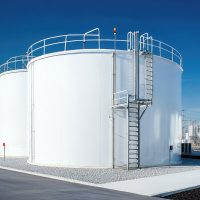Aboveground vs. Underground Storage Tank: Which Is Better?

When it comes to storing fuel, oil, chemicals, or other hazardous materials, choosing the right type of storage tank is a critical decision. Business owners, property managers, and developers often face the question: should you install an aboveground storage tank (AST) or an underground storage tank (UST)? Each option offers distinct advantages and potential drawbacks, and the best choice depends on your specific site conditions, regulatory requirements, and operational goals.
At Herbert Lutz & Company, we have decades of experience installing, removing, and servicing both ASTs and USTs across New Jersey and Florida. This blog post will walk you through the key differences between aboveground and underground tanks, highlighting the pros and cons of each so you can make an informed decision for your property or project.
Space and Location Considerations
One of the most obvious differences between ASTs and USTs is visibility. Underground tanks are buried beneath the surface, making them ideal for locations where space is limited or where aesthetics matter. They leave more usable surface area for parking lots, buildings, or landscaping, and they may be required in areas where aboveground tanks would be visually intrusive or create security concerns.
Aboveground tanks, on the other hand, require a dedicated footprint on your property. They must be placed in an accessible location, often with clearances and secondary containment systems to prevent spills from impacting nearby structures or stormwater systems. However, because they are easy to access, ASTs are generally easier and less expensive to inspect, maintain, and repair.
Installation and Maintenance Costs
When comparing upfront installation costs, ASTs typically win out. Aboveground tanks don’t require excavation, backfilling, or complex installation processes. That makes them quicker to install and less labor-intensive overall.
USTs involve significant site preparation, including digging, soil testing, and often groundwater management. These factors can make UST installation more expensive. Additionally, underground tanks often require more extensive monitoring systems and corrosion protection, which adds to long-term maintenance costs.
However, USTs can still be the better choice in many settings—especially when space or zoning limitations make aboveground installation impractical.
Durability and Lifespan
Both ASTs and USTs can last for decades with proper design, materials, and maintenance. However, their longevity can be affected by their environment. Underground tanks are constantly exposed to moisture, soil acidity, and potentially corrosive conditions. Modern USTs are designed with corrosion-resistant coatings and may include cathodic protection, but over time, degradation is still possible.
ASTs are exposed to weather conditions such as UV rays, temperature fluctuations, and storms. While these tanks avoid the problems caused by soil and groundwater contact, they may require weather-resistant coatings and protection from physical impacts.
From a maintenance standpoint, ASTs are easier to inspect for damage or wear because all components are visible. USTs require specialized testing and equipment to monitor for leaks, corrosion, and other failures hidden below ground.
Leak Detection and Environmental Risk
Leak detection is a critical factor when choosing a storage tank. With ASTs, leaks are usually easy to spot and can be addressed quickly. Spills or leaks are often contained within a visible area and can be cleaned up before they cause major environmental harm.
USTs, however, pose a greater risk in this regard. Leaks can go undetected for months or even years, allowing hazardous materials to contaminate the surrounding soil and groundwater. Cleanup of a leaking UST can be complex, costly, and subject to strict regulatory oversight.
For this reason, federal and state environmental agencies—including the New Jersey Department of Environmental Protection (NJDEP) and the Florida Department of Environmental Protection (FDEP)—have implemented stringent monitoring, testing, and reporting requirements for UST systems. These compliance requirements are essential but can also increase the operational costs of an underground tank over time.
Regulatory Compliance
Both ASTs and USTs are regulated, but the level of oversight differs. USTs are generally subject to more rigorous rules because of their greater potential for environmental harm. These include mandatory leak detection, corrosion protection, secondary containment, and routine testing.
ASTs also require permits and must comply with fire codes, building regulations, and environmental standards. Secondary containment and spill prevention plans are often required, especially for tanks storing petroleum or hazardous substances. However, the compliance process for ASTs is usually less intensive than for USTs.
Which One Is Better?
There is no one-size-fits-all answer to whether an AST or UST is “better.” The right choice depends on your goals, budget, location, and long-term plans.
An Aboveground Storage Tank may be the better option if:
- You want easier access for maintenance and inspections.
- You’re looking for a lower installation cost.
- You need to monitor your tank frequently and respond quickly to potential issues.
- You have enough space on your property to safely house the tank above ground.
An Underground Storage Tank may be preferable if:
- You need to maximize usable surface area.
- Aesthetics or security concerns make aboveground tanks undesirable.
- Local zoning or environmental regulations favor underground placement.
- You are willing to invest in higher upfront costs for long-term space efficiency.
Let the Experts at Lutz Help You Decide
Whether you choose an AST or a UST, proper installation and ongoing maintenance are key to safety, compliance, and performance. At Herbert Lutz & Company, we provide expert guidance at every stage—from site evaluation and permitting to installation, testing, servicing, and eventual tank removal or replacement.
Serving New Jersey and Florida since 1973, we bring decades of experience and industry knowledge to every project. If you’re unsure which type of tank is right for your property or facility, contact us today for a consultation. We’ll help you weigh your options, understand the regulatory landscape, and make a decision that aligns with your goals and protects your investment.
